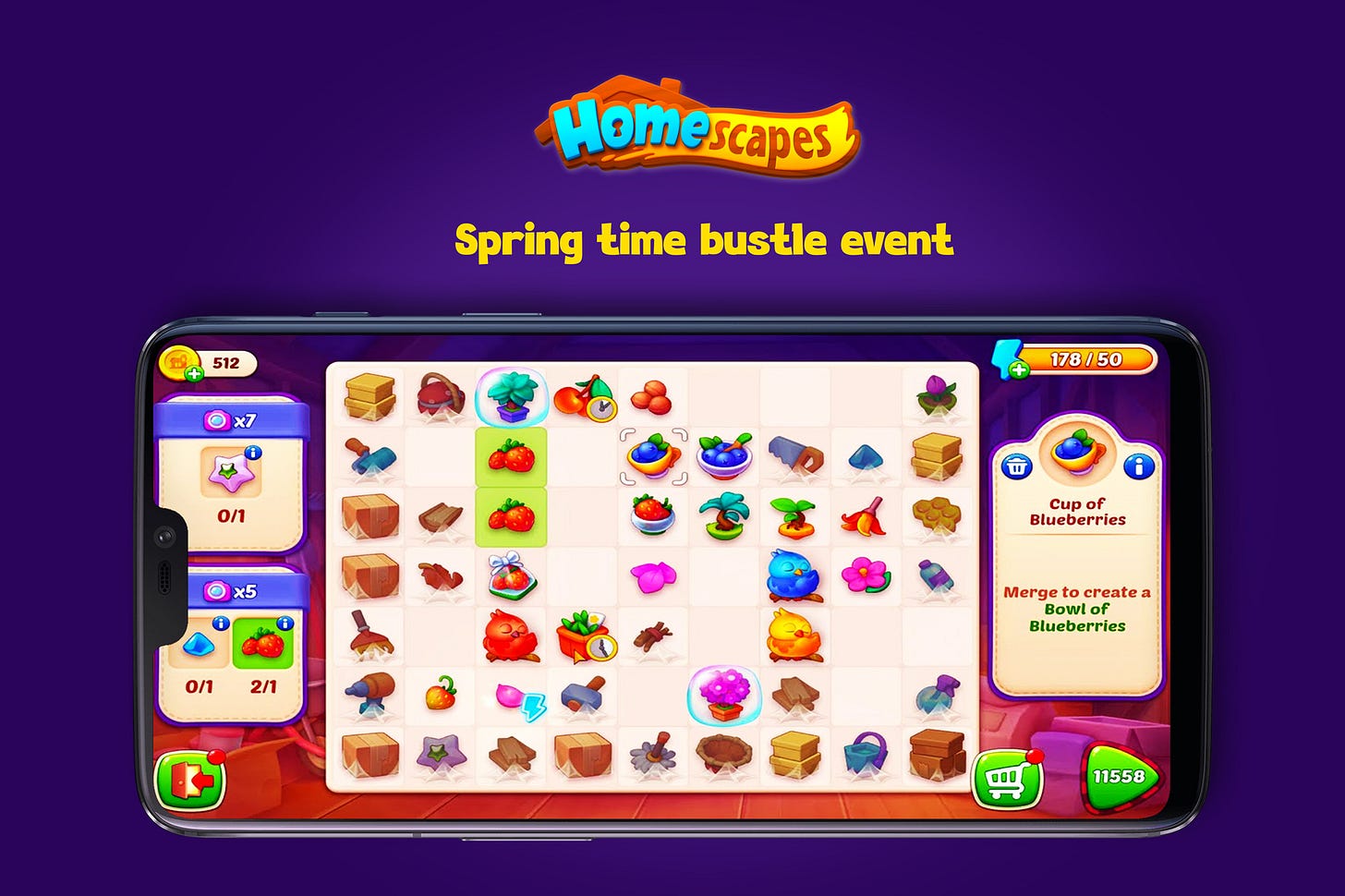This Week In LiveOps #7: Mini-Games To The Rescue
There's no mini-games in your big game? Uh oh. When you incorporate mini-games into your big-game, you can widen your audience, increase retention, and provide new monetization opportunities.
Lots of top-grossing games are adding mini-games into their liveops arsenal — and for good reason. Mini-games can easily add a whole bundle of benefits to your game with relatively easy work.
But before we dive in, here’s what we’ll talk about this week:
Benefits of implementing mini-games in your game
Examples of successfully implemented mini-games
The four main types of mini-games
What you can learn from mini-games
Ready? Okay, let’s go.
First, we’ll take a look at why mini-games make sense. The benefits might be glaringly obvious, but if not, we’ll break them down.
The benefits of mini-games
There are quite a few benefits to implementing mini-games, BUT the benefits will depend on how you utilize them. They’re a great way of boosting engagement by providing players with new and exciting ways of enjoying an existing game. You can also use them as a way to test how players respond to new gameplay mechanics if you want to eventually integrate them as a permanent mechanic in your core gameplay loop.
Introducing mini-games into your game also provides an opportunity to add new monetization elements.
Also, one of the big benefits of mini-games is being able to experiment with new genres, which means you’ll widen the motivational appeal of your game. This can make your player base larger and reduce your reliance on UA targeting, as adding these modes makes your game relevant to a larger audience.
Speaking of UA, many of the top-grossing games are choosing to implement hyper casual-like simple but addictive mini-games and utilize them in powerful ad creatives as part of their wider marketing efforts. These can be seen in numerous ads for mobile games on social channels, such as Austin’s Bad Dream in Gardenscapes.
Benefits of Mini-Games in LiveOps
There are lots of benefits to implementing mini-games in your game. Here are just a few:
Boosting retention: Mini-games boost engagement by providing players with a new and exciting way to enjoy an existing game
Rapid testing: If you eventually want to integrate a new mechanic into your core gameplay loop, you can rapidly test how players respond to it by trying out in a mini-game.
Monetization: They can provide an opportunity to add new monetization elements. As an example, a puzzle mini-game might feature consumable boosters or rewarded ads to help players in the levels, while a more complex standalone minigame might introduce a completely new monetized meta layer.
Broaden your target audience: One of the biggest benefits of mini-games is being able to experiment with new genres, which means you’ll widen the motivational appeal of your game. This can make your player base larger and reduce your reliance on UA targeting, as adding these modes makes your game relevant to a larger audience.
Bonus for the marketing team: In addition, many of the top-grossing games are choosing to implement hyper-casual-like simple but addictive mini-games and utilize them in powerful ad creatives as part of their wider marketing efforts.
You can also use a platform such as UserWise to personalized the game play to match the ad they clicked on. So for example, if you had an ad that promoted a highly addictive match3 game, you could segment the players who clicked on the ad to get more of the match3 mini games served to them. Did that make sense?
Examples of Mini-Games in LiveOps Events
Here are a few examples of how popular games are implementing mini-games as LiveOps events:
Homescapes
Homescapes added The Springtime Bustle Event based on the popular merge genre*,* and Winter Adventure Exploration Event similar to what you would see in top tycoon/crafting games like Klondike Adventures or Family Island. Having these mini-game events on a regular loop means Homescapes players are less likely to switch to a merge or tycoon/crafting competitor, as they’re getting the satisfaction of these genres from these additional game modes and reward systems.

Township
Township has launched a series of ongoing LiveOp mini-game events integrated into its core tycoon/crafting loop, including a Match3 puzzle makeover event (aka, Project Makeover), Mahjong Solitaire (Zen Match), and a bunch of hyper-casual games. Township feels almost like a platform of different mini-games of a variety of core mechanics from thinking-based to reaction/skill-based gameplay, which you are very incentivized to play to help you progress in the main farming/tycoon core game.
Free Fire
Free Fire, a top shooter game, released limited-time mini-game events that tap on viral trends, such as Pet Mania (a battle royale elimination party game, similar to Fall Guys/Stumble Guys) and Pet Rumble, which has similar gameplay to Among Us. Free Fire has also started to release simple mini-games in their themed events which you can play by earning tickets in the main battle royale mode.
Four Mini-Game Types
Mini-games can be grouped into four main types:
UA Creative Mini-Game Levels (Pure UA Approach): These often have a simple but engaging gameplay mechanic and are used in ad creatives to boost user acquisition and engage players through tutorial levels.
UA Creative Mini-Game as a Side Mode (Hybrid Approach): This archetype takes the first approach further by having the UA creative mini-game as a permanent side mode, combining the UA creative approach and retention-increasing permanent mode approach.
Proper Mini-Games in Live Events (Retention Approach): Mini-games are usually an integral part of the game, supporting the main gameplay or the event loop.
Permanent, Standalone Mini-Game Modes (Retention Approach): These are similar to the third archetype, but they are permanently available as side modes, sometimes with even more depth than the mini-games in the third archetype.
How to use the data
Adding mini-games to your main game can be a powerful tool for data collection and monetization. By leveraging the insights gained from mini-game engagement, you can improve your game design and monetization strategies, ultimately leading to a better player experience and increased revenue.
If you’re using a liveops platform that has personalization built-in, you can begin using the data to do a whole bunch of things. You’ll first need the ability to segment players out who played the game.
Here’s how you segment the players with UserWise. It’s pretty easy.
Once you have the segments built, you can begin delivering personalized content to those players.
Here are examples of what you can do with those segments:
Deliver a survey
Ask them what their motivations or interests are. Maybe players that play Match3 are very differently motivated than players who like trivia. Use this data to feed your UA strategy.Send a unique offer.
You can send a unique offer to the players who played the mini game. This opens a new way to monetize the game if your players have already been fatigued by your main game.Notify them with a message.
Once you have them interested in a mini-game, you can start sending them targeted messages to re-engage them with mini-game events or new mini-game levels etc.
Overall, adding mini-games to your main game can be a powerful tool for data collection and monetization. By leveraging the insights gained from mini-game engagement, you can improve your game design and monetization strategies, ultimately leading to a better player experience and increased revenue.
Conclusion
The trend of incorporating mini-games into LiveOps has grown significantly. Games such as Homescapes, Township, and Free Fire have successfully implemented mini-games., and by incorporating mini-games into your game, you can widen your audience, increase retention, provide new monetization opportunities, and test new gameplay mechanics fairly rapidly.
If you are looking to add new and exciting elements to your game, mini-games may be the answer.
🗣️ Read all about it!
❤️🔥 Player motivations: The carrot, the stick, and the holy grail
Human motivation is a strange thing. Stanislav breaks down our wild and crazy motivations and how game designers can use this knowledge to create engaging games that satisfy players' psychological needs.
💬 Some highlights we pulled for you to think over:
“Boosting one player’s ego can come at the expense of everyone else!”
“The players that are driven by Identified Motivation are the game’s Superfans! Treat them like royalty!”
“The bragging rights in games are so important.”
“Being a healer in the MOBA team is not directly beneficial to the individual player, but regarded highly by others.”
👩🍳 Hybrid-Casual Games: The Recipe for Long-Term Engagement
Here’s another summary on why you may want to move your game from hyper to hybrid. (if you haven’t started already)
💬 Some highlights we pulled for you to think over:
Hybrid-casual games have higher retention rates than casual and hyper-casual games
Hybrid-casual games can have a casual or a hyper-casual core, or a mix of both
Hybrid-casual games can include various meta layers and other features added to the core game
Hybrid-casual games can utilize advertising ARPDAU and reach one-year lifetime values of around $3
This newsletter is brought to you by UserWise.
UserWise makes it easy to operate your live game. Now you can remote configure anything while boosting revenue - all without bothering your developers.





